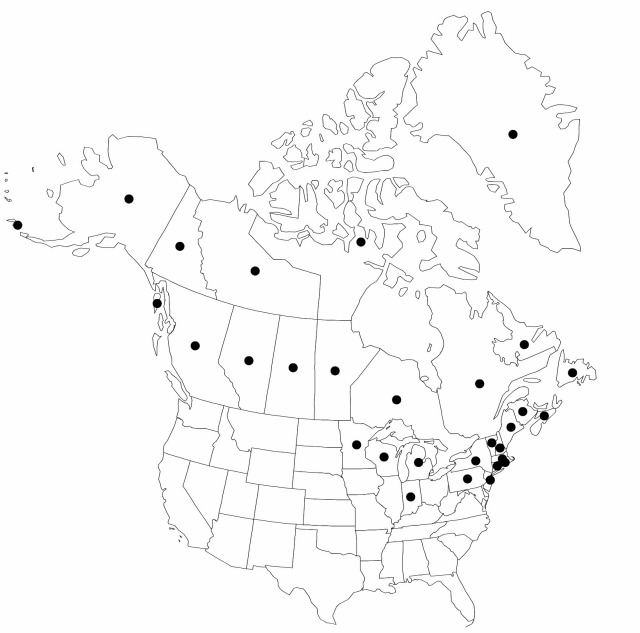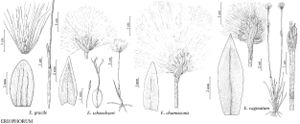Eriophorum vaginatum
Sp. Pl. 1: 52. 1753.
Plants cespitose, tussock-forming. Culms 10–60 cm; basal sheaths brown. Leaves: bladeless sheaths 1–3 per culm, expanding distally, to 1 mm wide; blades filiform, trigonous, not more than 1 cm. Inflorescences: involucral-bracts absent. Spikelets solitary, erect, globose-subglobose to ovoid-oblong, 10–20 mm in flower, to 50 mm in fruit; scales lead-colored to greenish gray with white-hyaline margins to 1 mm wide; empty scales more than 10, ovatelanceolate; proximal scales reflexed or spreading at maturity, 5–10 mm. Flowers: perianth bristles 10 or more, white, seldom reddish or brown, 10–18 mm, smooth; anthers 1–3 mm. Achenes ovoid to obovoid, 1.9–3.5 mm, apex minutely apiculate. 2n = 58, 60.
Phenology: Fruiting summer.
Habitat: Bogs, meadows, swales, tundra, wet places, peaty soils
Elevation: 0–500 m
Distribution

Greenland, Alta., B.C., Man., N.B., Nfld. and Labr., N.W.T., N.S., Nunavut, Ont., Que., Sask., Yukon, Alaska, Conn., Ind., Maine, Mass., Mich., Minn., N.H., N.J., N.Y., Pa., R.I., Vt., Wis., Eurasia
Discussion
Eriophorum vaginatum is variable; many authorities divide it into two subspecies, E. vaginatum subsp. vaginatum and E. vaginatum subsp. spissum (Fernald) Hultén, differing in spikelet shape, scale color, and anther size. The remarkable degree of morphologic overlap and the limited number of consistent characters that can be used to delimit the subspecies has been problematic and controversial. Many intermediates between the essentially sympatric subspecies occur, especially in the center of the range of the species. In the absence of definitive data only one taxon is recognized.
Selected References
None.
Lower Taxa
"shortened" is not a number."not undefined" is not a number.
